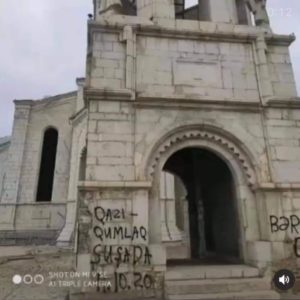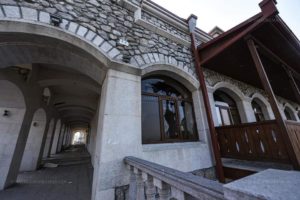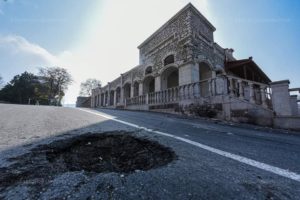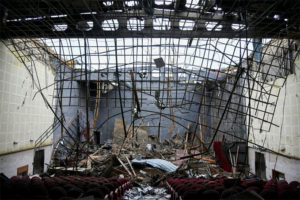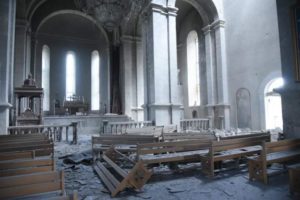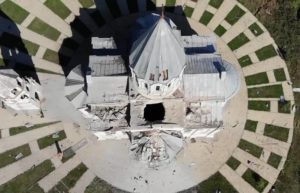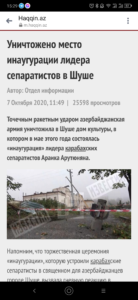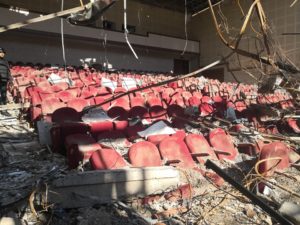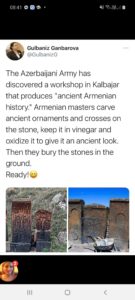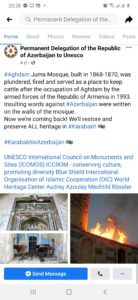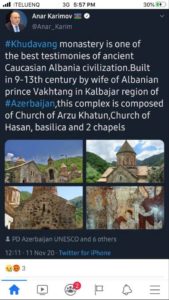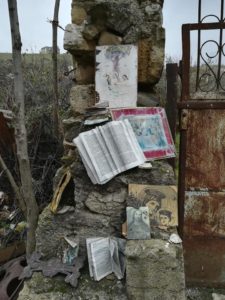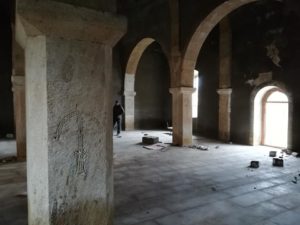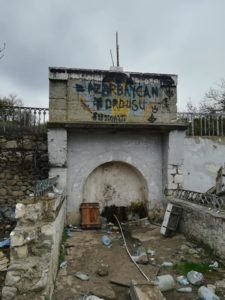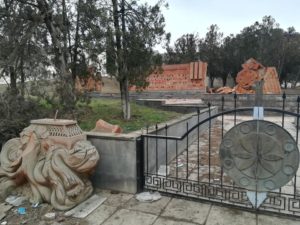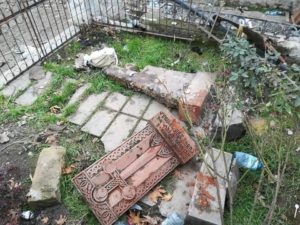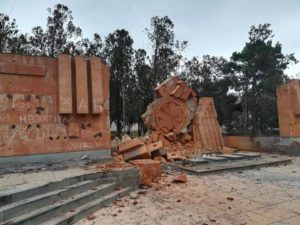November 30, 2020
A BRIEF REVIEW OF CULTURAL HERITAGE VIOLATIONS IN NAGORNO-KHARABAGH (ARTSAKH) IN SEPTEMBER-NOVEMBER OF 2020
26․11․2020, Yerevan, Armenia
On the 27th of September, 2020, on Sunday morning, violating the cease fire of 1994 Azerbaijan Armed forces attacked Armenian internationally not recognized state of Artsakh Republic. Among a number of war crimes against the civilians of Artsakh there were a number of severe violations recorded against the movable and immovable cultural heritage, objects of warship, education and cultural practices.
Due to the unexpected attack from the Azerbaijanian Army early in the morning on Sunday, the staff of the museums had no chance or time to evacuate their collections. Moreover, after the attack the settlements of Artsakh including capital Stepanakert, Shushi, Martuni, Martakert and other major towns were under constant fire with the use of internationally banned weapons. This situation made it almost impossible for the workers of the cultural heritage to go out from the bomb shelters and to take care of the collections during the war.
The movable heritage was/is preserved in 21 museums located in different parts of Artsakh. Twelve of which, that are located in the fortress city Shushi, in Hadrut and other regions of Artsakh under current jurisdiction of Azerbaijan, preserved a vast collection of the history, arts, religion, everyday life, nature and culture of the region. After the ceasefire signed between Armenia, Azerbaijan and Russia on the 10th of November, the Armenian side has no access and no information about the fate of the museum collections. Majority of the museums were created after the ceasefire in 1994, some of the collections are donations from private collectors to the state of Artsakh, they belong to the history, religion, creativity of the people of Artsakh, caring and promoting the moral, religious, traditional values of those people that have created them. Therefore we strongly recommend making the issue of protection and transfer of the collections to the people of Artsakh an inseparable part of the diplomatic negotiations.
The museums in the cities of Martuni and Hadrut have suffered most according to various sources. Some soldiers witnessed, that the old district of Hadrut city, where the museum is located, was burnt by Azerbaijani Army. The collections of some museums could be exposed to illicit trafficking in the near future. Interpol and other relevant international institutions should keep their attention on the possible cases of circulation of the cultural goods from Artsakh region.
It is sad to witness, that during the last decades’ destruction of Armenian cultural heritage is promoted and sponsored in Azerbaijan on the state level, which is turned into an everyday expression of hate against anything Armenian, in one word armenophobia[1] . This tradition is practices by Turks and Azeri for more than a century (during and after the Genocide of Armenians that was implemented in Turkey from 1890s till 1920s) and is called cultural genocide, which is accompanied with the ethnic cleansings.
Cultural genocide or cultural cleansing is a concept that lawyer Raphael Lemkin distinguished in 1944 as a component of genocide. The Armenian Genocide Museum defines cultural genocide as “acts and measures undertaken to destroy nations’ or ethnic groups’ culture through spiritual, national, and cultural destruction.
The monuments of Armenian historical and cultural heritage have been a subject of intentional destruction throughout centuries during armed conflicts, as well as in times of peace. Along with human lives lost, cultural heritage is under ongoing attacks and under danger of destruction on both sides. The cases of gross violation against the 1954 Hague Convention for the Protection of Cultural Property in the Event of Armed Conflict were many.
During the months of the war and nowadays videos and photos made by individual or groups of Azerbaijani soldiers being proud of fully “taking revenge” from the historical monuments, cross stones, memorials across the territories of Azerbaijani appearance in Artsakh, are many. Azerbaijanis express particular aggression against those historical monuments that may have Armenian inscriptions or crosses.
In the 21st c. when the progressive world promotes diversity tolerance, religious and cultural, moral high values, equality, peace, wellbeing in the minds of men and women, this sort of approach can prepare a feeling of impunity and indirectly impact further actions against the cultural heritage of Artsakh.
Though almost all professional international organizations have made statements,condemning and calling on the importance of the protection of the cultural heritage by referring to the UN Resolution 2347 on the protection of the cultural heritage located in the conflict zones, adapted on 2017th, we still witness gross violations as against humans, particularly war prisoners, so the religious and cultural heritages of Armenians of Artsakh. Constant propaganda on albanification of Armenian cultural heritage is the continuation of deliberate cultural cleansings by Azerbaijan on the territories under their jurisdiction. The fact of implementation of such actions on the level of state officials is considered to be a part of state policy, violating values of scientific, historical, religious, cultural, human rights of the indigenous people of the region.
Chronology of statements by international organizations for safeguarding the cultural heritage of Artsakh.
- On the 2ndof October, ICOM Armenia published its Statement on the Recent Aggression of Azerbaijan against Nagorno Karabagh.
- On the 5thof October, ICOM International has published a statement by “…strongly condemning any deliberate destruction of cultural heritage. … urging both parties to immediately cease fire…”.
- On the 7thof October, Blue Shield made a Statement on fighting in Nagorno-Karabakh “…urging [all parties] to recognize the need to not only prevent avoidable or unnecessary damage to the cultural sites of the region, but also to proactively strive to safeguard and respect all cultural property within the area where fighting is taking place.”
- On the 10thof October calling for cease fire, UNESCO has published a Statement on the Situation in the Nagorno Kharabagh Conflict Zone.
Even the calls and demands on the protection and safeguard from the side of the international organizations or prominent individuals didn’t stop violations after the cease fire of 10th of November.
On the 15th of November As an organization committed to safeguarding our shared global heritage, World Monuments Fund (WMF) continued to call for the protection of all cultural property within the Nagorno-Karabakh region.
- On the 17thof November, Statement from The Met on Armenian Cultural Heritage Sites was published; “… We implore all those involved to respect these international cultural heritage sites, which enrich our world and have survived for thousands of years. The loss of cultural heritage sites is permanent, and is a grievous theft from future generations.”
- The Article released by the Smithsonian Magazineon the 24th of November “Why Scholars, Cultural Institutions Are Calling to Protect Armenian Heritage?” present in details why serious measures should be taken on international level for safeguarding the Cultural heritage of Artsakh.
We call on the international professional societies and institutions committed to the safeguard of the historical cultural heritage, regardless nationality, religion or geographical location to combine our efforts and to call upon Azerbaijani government and society to prevent from the ongoing violations against cultural heritage of Artsakh.
Ani Avagyan
Chair of ICOM Armenia
[1] Anti-Armenian sentiment, also known as anti-Armenianism and Armenophobia, is a diverse spectrum of negative feelings, dislikes, fears, aversion, derision and/or prejudice towards Armenians, Armenia, and Armenian culture.
Some database on violations of cultural heritage.
https://haqqin.az/news/191076?fbclid=IwAR0jpq20jfiG3N98-qXwC-8DpROtYM8r7wWs55ArlTaBLIiFbo3ROPHdc8I
https://iravunk.com/?p=185223&l=am
The Kanach Zham Church in Shushi has been partially destroyed – FIP.AM
